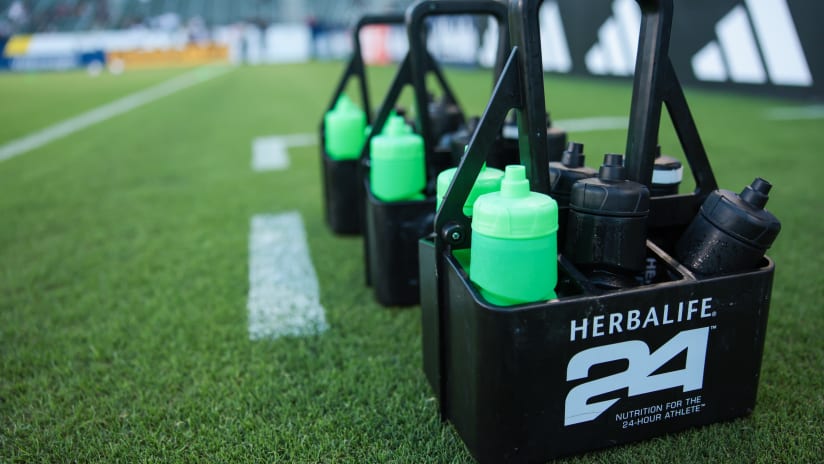Herbalife is the sports nutrition and presenting partner for the LA Galaxy. Herbalife Dietitians work closely with the LA Galaxy technical staff to make sure we are maximizing their nutrition to support performance goals.
With the major international women’s soccer competition currently at the forefront of sports media, there is no better time to discuss sports performance nutrition for female athletes. Please note that this article series is simply a primer on female sports nutrition and is not meant to substitute personalized advice from a Registered Dietitian who specializes in sports performance and/or women’s health.
Physiology
Should we really approach women’s sports nutrition differently than men’s? The answer to this question is a resounding “Yes!” However, the same overarching fueling principles still apply. We simply need to pay a little bit more attention to certain factors and be mindful of a few physiological differences and variances.
Men and women have differing physiology that can affect performance, and thus also impacts any nutritional choices aimed at improving performance. Women not only have the same daily circadian rhythm as men, but we also have an additional ~month-long menstrual cycle that has the potential to impact both health and performance.
In general, healthy, well-nourished female athletes do not have to worry too much about their menstrual cycle severely negatively impacting their performance.1 While some women experience more intense symptoms around their period, these can typically be managed through proper nutrition, lifestyle, and medications. Overall, more research needs to be done to better elucidate the relationship between the various menstrual cycle phases and specific performance targets.
Some female athletes may opt to track their cycles and find it helpful to tweak their diets dependent on which phase they are currently in.
For example, during the follicular phase of the menstrual cycle, it might be useful to focus on anti-inflammatory foods, omega-3s, and protein in order to reduce inflammation and promote repair and recovery within the body.2 On the other hand, during the luteal phase of the cycle, higher carb and protein intake may be more beneficial as glycogen stores are not as easily accessible during physical activity, which could lead to more muscle breakdown.3
Common Nutrition Concerns
There are a few common nutrition-related concerns related to females in sports, including body image, RED-S, bone health, tendon and ligament health, and common micronutrient deficiencies.
Body Image, Amenorrhea, and RED-S
Body image is a concern for any athlete, male or female, due to a general expectation of leanness. Combining this aesthetic expectation within the sports world with the immense societal pressure to look a certain way (which can be contradictory), the negative effect on body image in female athletes is often amplified.
Poor body image can directly lead to disordered eating, undernutrition, and overtraining, which reduces energy availability within the body. Low energy availability prevents the body from performing all of its necessary physiological functions, much less allowing you to perform at an optimal level. This often leads to amenorrhea (the cessation of menstruation), one of the signs of relative energy deficiency in sport (RED-S).4 RED-S is a condition characterized by general poor health and impairments to athletic performance and can be experienced by both males and females.4
Demanding training schedules coupled with long-term under-fueling can result in the following performance detriments:4
- Fatigue, decreased endurance, and trouble sleeping
- Decreased immunity and frequent illness
- Decreased metabolism
- Increased risk of injuries, stress fractures, and early onset osteoporosis
- Low heart rate, low blood pressure
- Decreased concentration, focus, and impaired judgment
- Poor mental health, anxiety, and depression
Therefore female athletes must ensure they are consuming adequate nutrition to sufficiently fuel the body for not only its fundamental physiological processes but also their intense training regimen and games. Using the presence of menstruation at regular times each month as a benchmark for overall health is one easy tool female soccer players can use to ensure they are not slipping into low energy availability.
RED-S is a serious condition that should be evaluated, treated, and monitored by a care team comprised of a physician, a Registered Dietitian, and a psychologist or disordered eating specialist.
Stay tuned for the next blog post, which will address the importance of nutrition in bone, tendon, and ligament health for female athletes.
References
1. Meignié A, Duclos M, Carling C, et al. The effects of menstrual cycle phase on elite athlete performance: A critical and systematic review. Front Physiol. 2021;12:654585. doi:10.3389/fphys.2021.654585
2. Chaireti R, Lindahl TL, Byström B, Bremme K, Larsson A. Inflammatory and endothelial markers during the menstrual cycle. Scand J Clin Lab Invest. 2016;76(3):190-194. doi:10.3109/00365513.2015.1129670
3. Devries MC, Hamadeh MJ, Phillips SM, Tarnopolsky MA. Menstrual cycle phase and sex influence muscle glycogen utilization and glucose turnover during moderate-intensity endurance exercise. Am J Physiol Regul Integr Comp Physiol. 2006;291(4):R1120-R1128. doi:10.1152/ajpregu.00700.2005
4. Dipla K, Kraemer RR, Constantini NW, Hackney AC. Relative energy deficiency in sports (RED-S): elucidation of endocrine changes affecting the health of males and females. Hormones (Athens). 2021;20(1):35-47. doi:10.1007/s42000-020-00214-w




